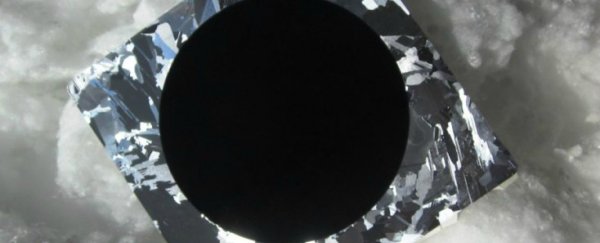There's been plenty of good news about solar power lately - not only are governments around the world using it more and more, we're now able to harvest the Sun's energy more cheaply and efficiently than ever before. But there's still one big problem: traditional solar cells simply don't work that well unless they're in direct, bright sunlight.
To rectify this, researchers have been working on creating structures called black silicon solar cells, which absorb way more light and are useful even on overcast days. But they've never been efficient enough to be real players in the solar race - up until now, that is.
A team of European researchers has just announced that they've set a new record by creating black silicon solar cells that can convert 22.1 percent of the Sun's light into electricity - an increase of almost four percent on their previous record. While this doesn't compare to the record of 40 percent efficiency in traditional silicon solar cells, it shows that black silicon solar cells are now real contenders that could help greatly reduce the cost of solar power in the future.
Even more impressively, the team compared their new black silicon solar cells with traditional solar cells of the same efficiency, and showed that their cells increased daily energy production by 3 percent, thanks to their ability to suck up light even when the Sun was low in the sky.
"This is an advantage particularly in the north, where the sun shines from a low angle for a large part of the year," project coordinator Hele Savin from Aalto University in Finland said in a press release. "We have demonstrated that in winter Helsinki, black cells generate considerably more electricity than traditional cells even though both cells have identical efficiency values."
What's different about black silicon solar cells is that their surfaces are covered in tiny, nano-scale ridges, which helps them absorb the most visible and infrared light possible. Once this light is captured, a quantum reaction occurs that results in the production of electrons. But because of all those nano-ridges, the electrons tend to recombine with the photovoltaic surface of the black silicon, rather than flowing through the cell as electricity - a problem that's created a limit to how efficient the cells could become.
To rectify this problem, the researchers from Aalto University worked with a team from the Universitat Politècnica de Catalunya in Spain and added a thin film to their nanostructures, as well as a thick coating to the back of the cells, which encourages the electrons to keep moving.
Publishing in Nature Nanotechnology, the researchers report that their resulting cells are the most efficient black silicon solar cells to date, capable of turning 22.1 percent of available light into electricity. "This means that the surface recombination issue has truly been solved and black silicon solar cells have real potential for industrial production," the authors write.
What's even more exciting about this research is the fact that the team hasn't optimised the new cells as yet, so there's potential for them to easily become more efficient, as well as cheaper. "Our record cells were fabricated using p-type silicon, which is known to suffer from impurity-related degradation. There is no reason why even higher efficiencies could not be reached using n-type silicon or more advanced cell structures," said Savin.
Their next step is to work on ways they can scale up the technology. "The surface area of the best cells in the study was already 9 cm2. This is a good starting point for upscaling the results to full wafers and all the way to the industrial scale," she added.
Basically, this means that we may soon see solar panels on the market that can create electricity no matter where the Sun is in the sky, and even on cloudy days. So if you weren't already excited about the future of solar energy, now is the time to jump on board.
